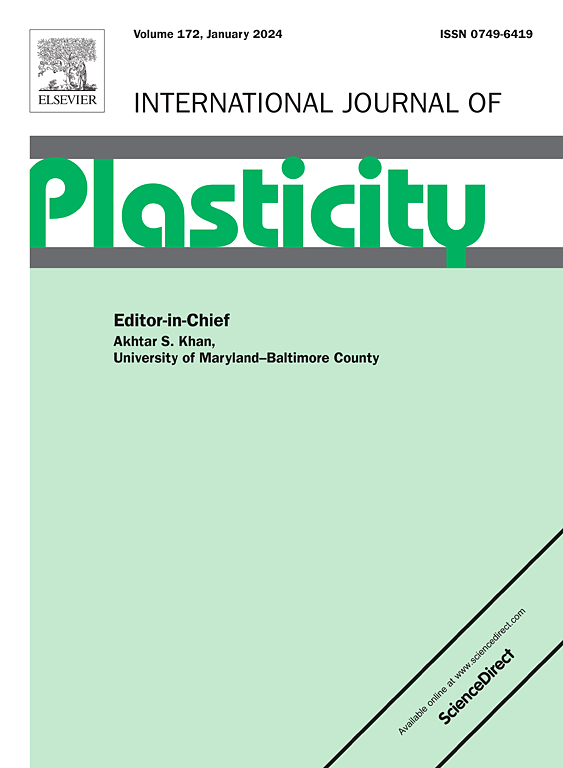Multiscale modeling of the damage and fracture behaviours of TA15 titanium alloy with trimodal microstructure
IF 9.4
1区 材料科学
Q1 ENGINEERING, MECHANICAL
引用次数: 0
Abstract
Trimodal microstructure, consisting of equiaxed α (αp), lamellar α (αl), and transformed β (βt), has become an ideal target microstructure of titanium alloys. However, the complex microstructure morphologies and the differences in mechanical property among the three constituent phases of the trimodal microstructure significantly influence its microscopic crack propagation behaviour and further affect its fracture toughness. To address this issue, a multiscale finite element (FE) model, including a microscopic crack propagation (micro-CP) model and a macroscopic fracture toughness (macro-FT) model, was established for analysis and prediction of the damage fracture behaviour and property of the trimodal microstructure. In this model, the deformation, damage and fracture behaviours of the trimodal microstructure at both micro and macro scales were described by bridging the constitutive laws of constituent phases and deformation responses. In tandem with this, the micro-CP model adopted a macro-micro nested structure, and the macro-FT model was developed based on a virtual fracture toughness test. Using the established multiscale FE model, the dependence of microscopic crack propagation and macroscopic fracture behaviours on the constituent phases of the trimodal microstructure was revealed. It is found that both αp and αl improved the path tortuosity and energy consumption of microscopic crack propagation, and αl decreased the microscopic crack propagation rate simultaneously. In addition, αp and αl contributed to the fracture toughness of the trimodal microstructure from both the intrinsic toughening mechanism (suppressing the heterogeneous deformation and damage and then decreasing the strength and increasing the plasticity) and the extrinsic toughening mechanism (increasing the tortuosity and energy consumption of crack propagation). The research provided an in-depth understanding of the damage and fracture behaviours of TA15 titanium alloy with the trimodal microstructure.


TA15钛合金三模态组织损伤断裂行为的多尺度模拟
由等轴α (αp)、片层α (αl)和转化β (βt)组成的三峰组织已成为钛合金理想的靶组织。然而,三模态组织中复杂的组织形态和三个组成相之间力学性能的差异显著影响其微观裂纹扩展行为,进而影响其断裂韧性。为了解决这一问题,建立了包括微观裂纹扩展(micro-CP)模型和宏观断裂韧性(macro-FT)模型在内的多尺度有限元(FE)模型,对三模态微观结构的损伤断裂行为和性能进行了分析和预测。在该模型中,通过连接组成相的本构规律和变形响应,在微观和宏观尺度上描述了三模态微观结构的变形、损伤和断裂行为。与此相对应,微观cp模型采用宏观微观嵌套结构,宏观ft模型基于虚拟断裂韧性试验建立。利用所建立的多尺度有限元模型,揭示了微观裂纹扩展和宏观断裂行为与三模态组织组成相的关系。结果表明,αp和αl均提高了细观裂纹扩展的路径弯曲度和能量消耗,αl同时降低了细观裂纹扩展速率。此外,αp和αl对三模态组织的断裂韧性有内在的增韧机制(抑制非均质变形和损伤,降低强度,提高塑性)和外在的增韧机制(增加弯曲度和裂纹扩展能耗)。该研究为深入了解TA15钛合金的三模态组织损伤和断裂行为提供了依据。
本文章由计算机程序翻译,如有差异,请以英文原文为准。
求助全文
约1分钟内获得全文
求助全文
来源期刊

International Journal of Plasticity
工程技术-材料科学:综合
CiteScore
15.30
自引率
26.50%
发文量
256
审稿时长
46 days
期刊介绍:
International Journal of Plasticity aims to present original research encompassing all facets of plastic deformation, damage, and fracture behavior in both isotropic and anisotropic solids. This includes exploring the thermodynamics of plasticity and fracture, continuum theory, and macroscopic as well as microscopic phenomena.
Topics of interest span the plastic behavior of single crystals and polycrystalline metals, ceramics, rocks, soils, composites, nanocrystalline and microelectronics materials, shape memory alloys, ferroelectric ceramics, thin films, and polymers. Additionally, the journal covers plasticity aspects of failure and fracture mechanics. Contributions involving significant experimental, numerical, or theoretical advancements that enhance the understanding of the plastic behavior of solids are particularly valued. Papers addressing the modeling of finite nonlinear elastic deformation, bearing similarities to the modeling of plastic deformation, are also welcomed.
 求助内容:
求助内容: 应助结果提醒方式:
应助结果提醒方式:


